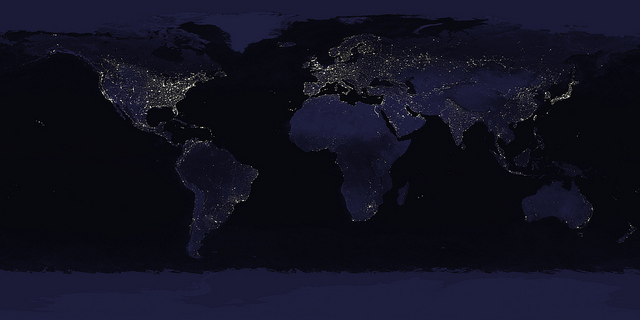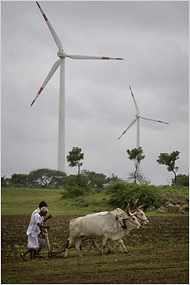 [This article was written by Cory Connolly and originally published at Mosaic.]
[This article was written by Cory Connolly and originally published at Mosaic.]
With the development of the smart-grid and distributed generation, the trend in energy seems to be local, but the future of the electric grid may in fact be more regional and global.
In the United States, as in many countries throughout the world, energy independence and energy security are often stated goals; however, energy independence and energy security are not synonymous. In fact, energy security of the future may be more attainable through energy interdependence. Clean energy is great, but the fact is renewable energy resources are intermittent and are often located great distances from cities and other load centers. To overcome these obstacles we’ll need storage advancements, more efficient transmission of electricity across great distances, and redundancy. With an internationally connected electric grid – a supergrid – renewable energy could more easily and reliably power the global economy.
The supergrid – while exact definitions vary – is essentially the creation of an international transmission grid which utilizes technologies that transmit electricity at high voltages across great distances more efficiently (this promotional video from Alstom helps explain). Supergrids are expected, by many, to play an important role in delivering large quantities of renewable energy to market.
AC/DC
As many are aware, the modern electric grid has three key components: generation, transmission, and distribution of energy. Energy coming from a variety of generation sources is transmitted across large distances at high voltages to load centers (like cities). When near load centers and the electricity’s eventual end-use, electricity is dropped to lower voltages for consumption. Transmission lines are either high voltage alternating current (HVAC) or high voltage direct current (HVDC). Throughout electric grids across the globe, AC is the standard currency. However, this may be changing – at least at the transmission level – thanks to advancement in HVDC technology. It is this advancement that is making the idea of a supergrid possible.
Direct Current Fueling the Supergrid
In the 1980s advancements in converter stations made HVDC transmission competitive with HVAC. HVDC technologies offer a number of advantages to HVAC, but the most notable advantages can be highlighted with the three most common uses of HVDC technologies:
1. Transmission of electricity at high voltages across large distances.
At distances greater than 700 km HVDC transmission lines are generally more cost effective than HVAC technologies, because they offer lower line losses. It’s in this way that HVDC technologies can help make large-scale, remote clean energy sources like wind, solar, and hydro power available and competitive.
2. Connecting Asynchronous Electric Grids and Creating Security
Many electric grids, including the United States’ three electric grids, are incompatible with one another. Whether it is due to differing frequencies or another dissimilarity that makes them incompatible, HVDC can bridge these barriers. DC electricity does not have a frequency and can be converted to any type of AC. Connecting separate grids via HVDC transmission facilities, whether through a line or a converter station (back-to-back), enables greater grid stability and allows for increased trade of electricity.
3. Submarine Cables, Connecting Ocean Energy Resources
Large offshore wind development is made possible by HVDC’s ability to transmit electricity at high voltages and across large distances under water.
These attributes make HVDC an ideal technology for regional power grid development and the incorporation of clean energy sources. With continued improvements, HVDC technologies could serve a foundational role in an international, regional, or even global supergrid.
Unlocking 100% Renewable Energy Around the World
The development of regional and international super grids and the increased use of HVDC technologies could be one way to unlock a 100% renewable energy future. While renewable energy like wind and solar are intermittent, at a global scale you can safely say “the wind is blowing and/or the sun is shining somewhere.”
Obviously, a regional supergrid is far off in the United States (and a global supergrid is hard to imagine). The supergrid, no matter the scale would require drastic increases in investment in transmission infrastructure and, clearly, would bring with it its own challenges (management of large flows of energy, maintenance, geopolitical considerations). Still, with the size of the United States and the wide range of renewable energy resources in different regions (solar in the southwest, wind in the great plains, and potentially tidal in the northeast), major investments in a highly efficient national transmission grid could be fruitful for the adoption of renewable energy. While not widespread, a few promising applications have been adopted in the United States. For example the Tres Amigas converter station and other projects are using HVDC to connect the Rasyern, Western, and ERCOT electric grids. The Atlantic Wind Connection will bring offshore power to cities throughout New England.
Still, other regions of the world are moving on this concept. Europe, led by an organization called Friends of the Supergrid, is devising a long-term plan to create a grid that connects all of Europe and – in some scenarios North Africa – via highly efficient transmission infrastructure. Current investments in HVDC and the development of a supergrid are seen as a key component in achieving the Europe’s 2030 renewable energy goals. Countries throughout Europe, led in large part by efforts in Germany, have dedicated funding to transmission upgrades that could help make the supergrid a reality, but plenty of work remains to be done.
In Asia, organizations in Japan have shown interest in these concepts as a strategy to move away from nuclear power, with the Japan Renewable Energy Foundation planning on hosting the International Symposium: Roadmap to A Supergrid in January of 2014. China has also invested heavily in HVDC transmission, helping it take advantage of vast hydroelectric resources and opening up new opportunities throughout the country.
This Reuters article from 2012, helps give a snapshot at some of the progress that has been made on supergrid development in various regions and countries. Beyond regional efforts, the Global Energy Network Institute has been promoting these concepts, but at a global scale.
In a sector increasingly shaped by distributed technologies and local energy generation, a 100% renewable energy future may be more global and interdependent than we think.
[Image: NASA]



